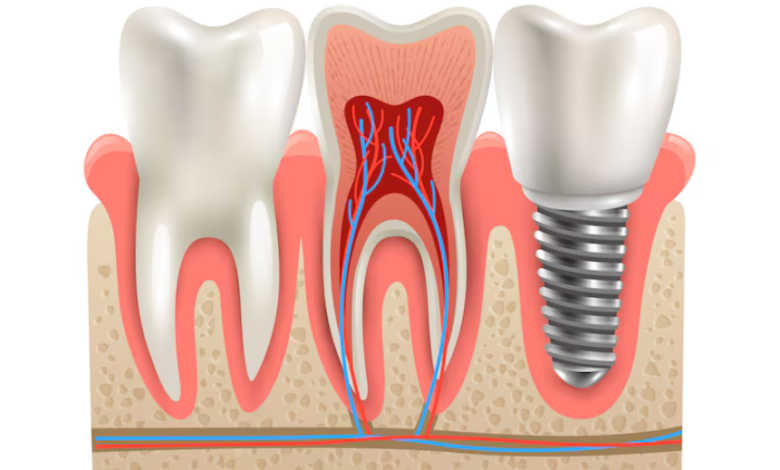How Soon You Can Resume Normal Eating After a Root Canal

Understanding Your Root Canal Procedure
A root canal might sound scary, but it’s a common dental procedure designed to save a tooth that’s badly decayed or infected. Think of it as a way to clean out the “nerve” inside your tooth, which is technically called the pulp. When that pulp gets damaged, it can cause a lot of pain and needs to be removed.
What Happens During a Root Canal?
So, what actually goes on when you’re in the chair? Your dentist, or perhaps an endodontist (a root canal specialist), will first numb the area around the tooth. They’ll then make a small opening in the crown of the tooth to get to the pulp chamber. After that, they carefully remove the infected or damaged pulp. The inside of the tooth is cleaned and shaped, and then it’s filled with a special material. Finally, the opening is sealed, and often, a temporary filling is placed. Sometimes, a crown is needed later to protect the tooth.
Why Is There Post-Procedure Sensitivity?
It’s pretty normal to feel some sensitivity or discomfort for a few days after a root canal. This is because the area around the tooth might be a bit inflamed from the procedure itself. The nerves in the jawbone can also be a little irritated. This temporary discomfort is usually manageable with over-the-counter pain relievers. It’s not a sign that the root canal failed, just a normal part of the healing process. If you’re experiencing severe pain or swelling, it’s always a good idea to contact your dentist, whether it’s your regular dentist or an emergency dentist San Diego if you’re in the area and need immediate attention.
Immediate Post-Treatment Eating Guidelines
The First Few Hours After Your Visit
So, you’ve just had a root canal. Congrats on getting through it! Now, about eating. For the first few hours, especially if your mouth is still a bit numb from the anesthetic, it’s best to stick to liquids or very soft foods. Think smoothies, yogurt, or lukewarm soup. The goal is to avoid any accidental biting of your tongue or cheek while you can’t feel it properly. It’s also a good idea to avoid anything too hot, as your sensitivity might be a bit off.
Avoiding Certain Food Textures
Once the numbness wears off, you can start thinking about slightly more substantial foods, but still, take it easy. Crunchy things like chips or hard candies are a definite no-go for now. Anything that requires a lot of chewing or could potentially break apart into sharp pieces should be avoided. This includes things like popcorn, nuts, or even crusty bread. You don’t want to put unnecessary pressure on the treated tooth or risk irritating the area. It’s all about giving your mouth a chance to start healing without any extra stress.
Here’s a quick rundown of what to steer clear of immediately after:
- Hard candies
- Popcorn
- Nuts and seeds
- Chewy candies like taffy
- Very hot or cold beverages
- Crunchy snacks like chips or pretzels
Transitioning Back to Your Regular Diet
So, you’ve had your root canal, and you’re probably wondering when you can get back to enjoying your favorite meals without a second thought. It’s a common question, and the answer isn’t a simple ‘tomorrow.’ Your mouth needs a little time to recover, and jumping back into tough foods too quickly can cause problems.
When Can You Eat Solid Foods?
Generally, after the numbness from the anesthetic wears off, you can start eating softer solid foods. However, it’s best to wait until your dentist gives you the all-clear, especially if a permanent filling or crown hasn’t been placed yet. If you have a temporary filling, you’ll want to be extra careful. Think about foods that don’t require a lot of chewing.
Gradual Reintroduction of Chewy Foods
Once you’re cleared for more solid options, ease back into chewy foods. Start with things that are a bit yielding, like well-cooked pasta or tender pieces of chicken. Avoid anything that’s really tough or sticky, like caramel or hard candies, for a while longer. Listen to your body; if something feels uncomfortable, back off and try something softer.
The Role of Your Dentist Rancho Bernardo
Your dentist is your best guide through this recovery. They know the specifics of your procedure and can tell you exactly what to expect and when. Don’t hesitate to call their office if you have any questions about what you can or can’t eat. They might have specific instructions based on how your treatment went.
Remember, patience is key. Rushing the process could lead to discomfort or even damage to the treated tooth.
Foods to Favor and Foods to Avoid
After your root canal, what you eat can make a big difference in how you feel and how your tooth heals. It’s not just about avoiding pain; it’s about giving your mouth the best chance to recover.
Soft Food Options for Comfort
When you’re first getting back to eating, sticking to softer foods is a smart move. Think about things that don’t require a lot of chewing. Smoothies are great because you can pack a lot of nutrients into them without any effort. Yogurt, applesauce, and mashed potatoes are also good choices. Even scrambled eggs or a soft-cooked fish can be easy on your mouth. The goal is to minimize any pressure on the treated tooth.
- Creamy soups (lukewarm, not hot)
- Oatmeal or other soft cereals
- Avocado
- Pudding or Jell-O
- Well-cooked pasta
Foods That Could Cause Complications
There are definitely some foods you’ll want to steer clear of for a while. Anything too hard, crunchy, or sticky can put stress on your tooth and potentially cause problems. This includes things like popcorn, hard candies, and even tough, chewy meats. You also want to avoid anything that’s extremely hot or cold, as temperature sensitivity is common after a root canal.
It’s best to avoid biting down on anything hard with the treated tooth.
- Nuts and seeds
- Ice cubes
- Caramel or taffy
- Raw vegetables like carrots
- Crusty bread
Hydration and Its Importance
Don’t forget about drinking plenty of fluids. Water is always the best choice. Staying hydrated helps your body heal and can also keep your mouth from feeling dry, which is sometimes a side effect of dental work. Try to avoid sugary drinks, as they aren’t great for your overall oral health. Warm (not hot) herbal teas can be soothing.
Keeping your mouth moist and your body hydrated supports the healing process. It’s a simple step that really helps.
Managing Discomfort and Swelling
It’s pretty normal to feel some discomfort or notice a bit of swelling after a root canal. Your mouth is just recovering from the procedure, after all.
Pain Management Strategies
Dealing with the ache is usually straightforward. Over-the-counter pain relievers are often all you need. Things like ibuprofen or acetaminophen can make a big difference. Just be sure to follow the dosage instructions on the package, and if you have any health conditions or are taking other medications, it’s always a good idea to check with your dentist rancho bernardo or doctor first. Sometimes, a cold compress applied to the outside of your cheek can help reduce swelling and numb the area a bit. Just wrap it in a thin towel so you don’t get frostbite!
- Take recommended over-the-counter pain relievers.
- Apply a cold compress to the outside of your cheek.
- Rest with your head slightly elevated.
Recognizing Signs of Infection
While most post-root canal discomfort is normal, you do need to keep an eye out for anything that seems out of the ordinary. Persistent or worsening pain, significant swelling that doesn’t go down, a fever, or a bad taste in your mouth could be signs of an infection. If you notice any of these symptoms, don’t hesitate to call your dentist right away. It’s better to be safe than sorry, and catching an infection early is key to a smooth recovery. They can advise you on the next steps, which might involve a follow-up appointment or a prescription for antibiotics.
Long-Term Oral Health After Treatment
Maintaining Good Oral Hygiene
Taking care of your teeth after a root canal is pretty straightforward, but it does require a little extra attention. You’ll want to stick to your regular brushing and flossing routine, just like always. Make sure you’re gentle around the treated tooth, especially in the first few days. Using a soft-bristled toothbrush can really help prevent any irritation. It’s also a good idea to consider an antimicrobial mouthwash, but check with your dentist first to make sure it’s okay for you. Keeping the area clean helps prevent bacteria from causing any new problems.
Regular Check-ups with Your Dentist Rancho Bernardo
Don’t forget about your dental appointments! Seeing your dentist regularly is super important, especially after a procedure like a root canal. They can check on the treated tooth, make sure everything is healing up nicely, and catch any potential issues before they become big problems. Think of it as a follow-up to make sure the repair job is holding up. These check-ups are key to making sure your root canal treatment lasts for the long haul. Your dentist can also give you personalized advice on how to best care for your teeth moving forward. It’s always better to be safe than sorry when it comes to your smile!
So, When Can You Eat Normally Again?
Alright, so we’ve talked about what to expect after your root canal. Most of the time, once that numbness wears off and you’re not feeling too much pain, you can start eating softer foods. Don’t go biting into a hard apple right away, though. Your dentist will give you the best advice for your specific situation, but generally, you’ll want to take it easy for a day or two. Listen to your mouth, and if something feels off, stick to the mushy stuff a bit longer. It’s all about letting that tooth heal up properly so you can get back to enjoying all your favorite foods without worry.
Frequently Asked Questions
What should I eat right after my root canal?
After a root canal, your tooth might feel a little numb or sore for a few hours. It’s best to stick to soft foods like yogurt, smoothies, or mashed potatoes while the numbness wears off. This helps prevent accidentally biting your cheek or tongue and keeps the treated tooth from getting too much pressure.
When can I go back to eating regular food?
Generally, you can start eating more normal foods the day after your root canal, but it’s smart to take it slow. Avoid anything super hard, sticky, or crunchy for a few days. Think about things like pasta, scrambled eggs, or soup. Listen to your mouth – if it feels sensitive, stick to softer options a bit longer.
How long should I wait to eat chewy foods?
It’s a good idea to wait until your dentist says it’s okay, usually after a few days, before you try eating chewy foods like bread crusts or tough meats. Start with smaller bites and see how your tooth feels. If it causes any discomfort, go back to softer foods.
Are there any foods or drinks I should stay away from?
You should definitely avoid very hot or very cold drinks and foods right after the procedure. Your tooth might be more sensitive to temperature changes. Warm or room temperature items are usually best until you feel more comfortable.
What kind of foods could damage my tooth after treatment?
Yes, it’s important to be gentle. Avoid chewing directly on the tooth that had the root canal, especially in the first few days. Try to use the other side of your mouth. Also, steer clear of things like popcorn kernels, hard candy, or ice, as these can really hurt your tooth.
How important is drinking water after a root canal?
Drinking plenty of water is super important for overall healing and keeping your mouth clean. Water helps wash away any food bits and keeps you hydrated, which is good for your body as it recovers. Just make sure it’s not too hot or too cold!





